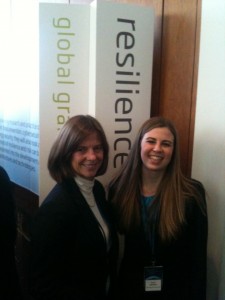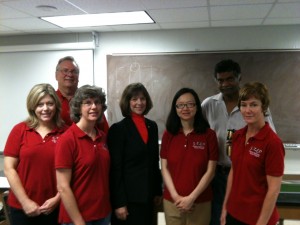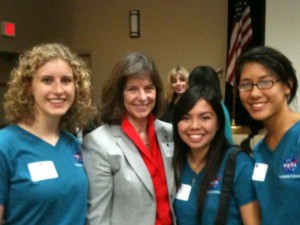Changing the Conversation: Cat 5

Katie Speights, UT Austin chemical engineering student, with Dr. Bonnie Dunbar. Katie was the winner of the International NAE Film Competition.
In 2005, the National Academies published Rising Above the Gathering Storm (RAGS), which provided clarity to what many of us had suspected with respect to science and math education in this nation. Complementary NSF data documented the declining interest in high school graduates to follow STEM careers. The 2010 National Academies report Rising Above the Gathering Storm, Revisited: Rapidly Approaching Category 5 lamented the fact that the needle was not moving forward.
At the same time, many educational working groups identified a bright point: the critical role played by the Informal Science Education (ISE) community of museums and science centers in motivating youth to follow STEM careers. It was recognized that we need to not only educate our youth, we need to inspire them—as well as their parents, and the community. I personally observed the strength of inspiration from the many hundreds of speeches I have given about space exploration to world-wide audiences, for more than three decades. It wasn’t surprising to me: I am a bit biased in this regard. Inspiration from the Apollo program motivated me to study algebra, and then later to leave the ranch so that I could help build Space Shuttle Columbia.

University of Houston physics faculty working with high school physics teachers.
We have many STEM challenges in Texas, as well as proposed solutions. These were addressed in the TAMEST report, The Next Frontier: World Class Math and Science Education for Texas. Houston has its own unique challenges, which we hope to successfully address through the UH STEM center. This Center will serve to promote collaboration within existing university programs, strengthen those that are successful, incorporate best practices, and participate more proactively in external partnerships and networks. The UH programs include teachHouston, replicated after UTeach, the Scholar Enrichment Program (SEP) for science and math undergraduates, PROMES for engineering undergraduates, the Mars Rover Program for elementary and middle school students, and various teacher enrichment programs.
When I was the President and CEO of the Museum of Flight in Seattle, Washington, I made several observations which I hope to bring to bear in my new role at the University of Houston. One of the strengths of the museum is its focus on the people, not just the history and the “things” of aviation and space. We incorporated local aviators, engineers, innovators, designers, and astronauts into the exhibits so that our young K-12 visitors could see themselves in these roles. We also included “hands on” experiences and interactive exhibits, as well as “inspirational” visual media.

WISH students at the NASA Johnson Space Center.
In the TAMEST report, I was particularly struck with a similar thought by Dr. Larry Faulkner, President Emeritus of The University of Texas at Austin: “In the world at large, a more positive image of STEM careers and the people who pursue them must be conveyed.” The report discussed the role that the media and the internet have on the public perceptions of science and engineering and the people who are in those careers. I suggest that the role that the media plays is far more critically significant than we currently understand, and that we will not make the large scale STEM preparation and enrollment changes we need to make in the short time we have left, unless we engage those who control the planned content in all public media and participate more fully in contributing to its content.
There are many examples of how we have lost control of the message in the last 50 years, as the primary communication mediums have changed from newspapers, TV stations which had much more local programming, and radio, to cable TV, the Internet (with Facebook and Wikipedia), and portable phones with texting and Twitter. Let me provide three very recent personal examples of the results of poor STEM imaging:
- In a recent encounter with a high school counselor, she advised me that she didn’t recommend engineering to her students because “my students like to work with people.”
- At a recent luncheon with about forty 17-year-old young women invited to the NASA Johnson Space Center to participate in the WISH program, they told me that while they were encouraged into STEM by their parents and teachers, they didn’t understand why “society” wasn’t encouraging them. I asked what they meant by “society,” and they answered “you know, the internet and reality TV shows.” They shared with me that they thought “society” valued them more for how they looked, rather than what they knew or did.
- On a recent CSI episode (Miami), the female Ph.D. Aerospace Engineer, who was widely published and successful, murdered a woman so that she could take her place as a TV soap opera lead. Her reason? To change careers because she couldn’t get a date as an engineer.
In order to address the imaging and messaging challenge, the UH STEM Center is not only developing the “traditional” website (to be launched soon), but also has its own Facebook page and Twitter account. So do I. Engaging in Twitter and Facebook can be daunting and risky, but used intelligently and carefully, it can provide more positive and realistic imaging for youth (and many adults). When I meet with students or scientists and engineers, I often take a “phone” picture and tweet it. My staff will also post it to Facebook. Some of those pictures are included in this blog. These are faces of future engineers and scientists. We have also engaged PBS Ch8, which resides at the UH campus. President Lisa Shumate is a strong supporter of STEM programming, and we are working together to find funds for new content. Even this may not be enough. It is time that we engage the networks, Hollywood, cable TV, the producers, Google, Bing, and the “writers” at a national level. They need to see our data. They use the technology we develop; in fact, their business models depend upon it. In 2008, the National Academies published Changing the Conversation: Messages for Improving Public Understanding of Engineering to provide well vetted public messaging about STEM careers. How do we move it forward?
Dr. Bonnie J. Dunbar’s professional experience spans industry, academia, government, and the non-profit sectors. She has been a practicing engineer recognized as a “Fellow” by peer groups and appointed to lead national teams evaluating future space exploration technology development, microgravity science development, and human space operations for the National Academy of Engineering. She was a five-time Space Shuttle Astronaut with more than 50 days in space and an integral member of the research and operations development teams for those flights. Recognized with NASA Spaceflight and Leadership medals, Dr. Dunbar is the recipient of seven honorary academic degrees and invited university lectures. She has been recognized for developing and supporting STEM programs in schools and with Informal Science Education (ISE) institutions. She is skilled at developing operational excellence within culturally diverse environments and creating a collectively supported strategic vision. Dr. Dunbar is an internationally recognized speaker who is frequently requested to lecture on topics related to human spaceflight, spacecraft design, spaceflight research operations, microgravity research, and STEM careers.
Dr. Dunbar was recently elected to the august Executive Committee of the International Association of Space Explorers (ASE) at the XXV Planetary Congress of the ASE, held last year in Saudi Arabia. She is the first woman space flier in that committee’s 25-year history. In April, she was inducted into the Astronaut Hall of Fame in Florida.
In 2013, she returned to the University of Houston as a professor in the Department of Mechanical Engineering and to lead a new STEM center (science, technology, engineering and mathematics), dedicated to improving STEM education and literacy and encouraging more young people to study these fields in college. In June, Dr. Dunbar was also named the new director of the college’s Aerospace Engineering Program.
Dr. Dunbar was elected to the National Academy of Engineering (NAE) in 2002 and was a founding member of The Academy of Medicine, Engineering and Science of Texas (TAMEST) Board of Directors in 2004.

